Product Detail
Product Namep65 Antibody
Host SpeciesRabbit
ClonalityPolyclonal
PurificationAntibodies were purified by affinity purification using immunogen.
ApplicationsWB,IHC,IF
Species ReactivityHuman,Mouse,Rat
SpecificityThe antibody detects endogenous level of total p65 protein.
Immunogen TypeRecombinant Protein
Immunogen DescRecombinant protein of human p65.
Target Namep65
ConjugateUnconjugated
Other NamesRELA; MGC131774; NFKB3; p65;
Accession NoSwiss-Prot:Q04206
NCBI Gene ID:5970
Uniprot
Q04206
Gene ID
5970;
Sdspage MW65KD
Concentration1.0mg/ml
FormulationSupplied at 1.0mg/mL in phosphate buffered saline (without Mg2+ and Ca2+), pH 7.4, 150mM NaCl, 0.02% sodium azide and 50% glycerol.
StorageStore at -20˚C
Application Details
WB 1:500 - 1:2000
IHC 1:50 - 1:200
IF 1:50 - 1:200
IP 1:50 - 1:100
Immunofluorescence analysis of U2OS cells using NF-kB p65 .
Western blot analysis of extracts of various cell lines, using NF-kB p65 at 1:1000 dilution.
Immunohistochemistry of paraffin-embedded human stomach using NF-kB p65 at dilution of 1:200 (40x lens).
Transcription factors of the nuclear factor κ B (NF-κB)/Rel family play a pivotal role in inflammatory and immune responses (1,2). There are five family members in mammals: RelA, c-Rel, RelB, NF-κB1 (p105/p50), and NF-κB2 (p100/p52). Both p105 and p100 are proteolytically processed by the proteasome to produce p50 and p52, respectively. Rel proteins bind p50 and p52 to form dimeric complexes that bind DNA and regulate transcription. In unstimulated cells, NF-κB is sequestered in the cytoplasm by IκB inhibitory proteins (3-5). NF-κB-activating agents can induce the phosphorylation of IκB proteins, targeting them for rapid degradation through the ubiquitin-proteasome pathway and releasing NF-κB to enter the nucleus where it regulates gene expression (6-8). NIK and IKKα (IKK1) regulate the phosphorylation and processing of NF-κB2 (p100) to produce p52, which is then translocated to the nucleus (9-11).
NF-κB assembly with IκB, as well as its DNA binding and transcriptional activity, are regulated by p300/CBP acetytransferases that principally target Lys218, Lys221 and Lys310 (12-14). This process is reciprocally regulated by histone deacetylases (HDACs); several HDAC inhibitors have been shown to activate NF-κB (12-14).
If you have published an article using product 32705, please notify us so that we can cite your literature.
et al,Di-Ras2 promotes renal cell carcinoma formation by activating the mitogen-activated protein kinase pathway in the absence of von Hippel-Lindau protein.In Oncogene. 2020 May;39 by Rao H, Li X,et al..PMID: 32161311
, (2020),
PMID:
32161311





 Yes
Yes



